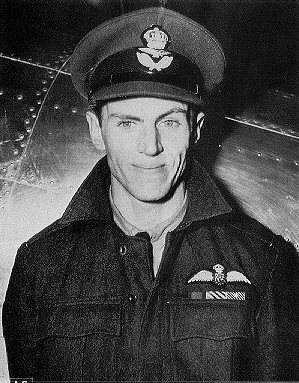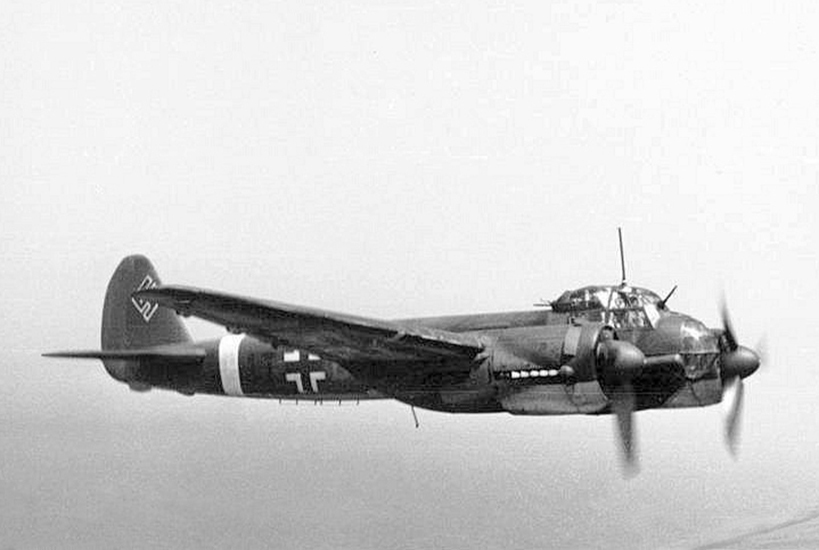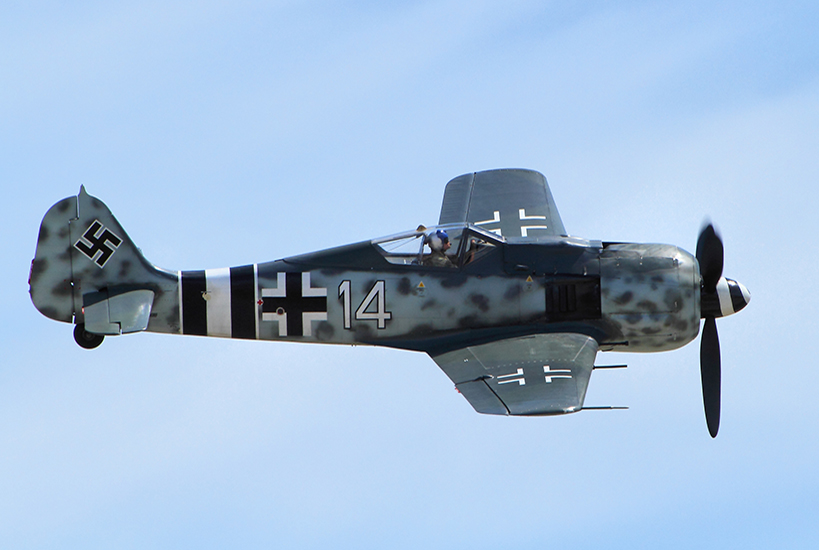Beurling, George Frederick "Buzz"
- Date of birth:
- December 6th, 1921 (Verdun/Quebec, Canada)
- Date of death:
- May 20th, 1948 (Rome, Italy)
- Nationality:
- Canadian (1931-present, Constitutional Monarchy)
Biography
George Frederick Beurling was born December 6th, 1921, in Verdun, Quebec, Canada and became the most successfull Canadian fighterpilot of WW 2. Almost all in his youth led to only one thing: his desire to fly. This became apparent from his spending much time on the Cartierville airfield near his home and by building model aeroplanes that he tried to sell to raise money for flying lessons. At the age of 12, he took his first flying instructions and flew solo for the first time in the winter of 1938. He quit school in the 9th grade and left his parental home to go to Gravenhurst, Ontario by train. In Gravenhurst, he was employed as copilot in an airfreight company, gaining vast experience.
After having earned his pilot's license, Beurling left for Vancouver to obtain his trade permit. He wanted to join the Chinese air force to fly against the Japanese who had invaded China. In order to reach China, he tried to enter the US illegally but was apprehended and imprisoned for two months.
After having been sent back, he reported to the Royal Canadian Air Force since Canada had become involved in WW 2 but he was rejected for his lack of education.
When the Russians were fighting against the Finns, he wanted to go to Europe to fly in the Finnish air force. Since he was still under 18, the Finnish embassy required consent from his parents which they refused to give.
During the spring of 1940, the British RAF was looking for experienced pilots which prompted him to go to England. He boarded the Swedish ammunition vessel Valparaiso and embarked on a hazardous journey. On arrival in Glasgow, he reported to the RAF recruiting office. They were impressed by his qualifications but in order for him to be registered, a birth certificate was required which he could not produce. Frustrated, he returned home, surviving a torpedo attack on his ship on the way to Canada.
September 1940, he returned to Scotland with a birth certificate and although he possessed the necessary qualifications, he declined officers' training and was posted as Sergeant-pilot in 403 Sq. RCAF. In 1941, he was transferred to 41 Sq. RAF and with this unit, he scored his first victory over France. In doing so however, he had left his formation without permission. After having been cited for lack of discipline, he scored a second victory in a similar way. Disciplined flying clearly wasn't his style.
Following this, he voluntarily applied for a transfer to 249 Sq. RAF on Malta. June 7th, 1942, he boarded the carrier HMS Eagle in Gibraltar along with the pilots and 32 new Spifires Mk IV. Two days later, he took off from HMS Eagle for a long and hazardous flight over the Mediterranean but arrived safely in Takali, Malta.
On July 6th, 1942, he was credited with three more victories, raising his total to five and making him an official ace. Due to his unflagging concentration and high degree of consciousness, he further developed his capability of defelction shooting and it was soon recognized that he was a perfect shot. Like many successfull pilots flying Spitfires, he attacked his adversary at less than 250 yards, a distance at which most pilots broke off their attack. On Malta, he earned the nickname 'Screwball'. On the ground, he was inclined to stay alone and while in the air, he invoked the anger of his superiors for his disdain of teamwork.
July 27th, 1942, he encountered the Italian ace Furio Niclot and shot him down, along with his wingman Falerio Gelli and two German Messerschmitt Bf 109 fighters. For this achievement he was awarded a DFM (Distinguished Flying Medal) and his total of victories was raised to eight.
At the close of July, he was promoted to Pilot-Officer and received a bar to his DFM with 17 confirmed victories. The exhaustion of the daily fighting, the dysentery and the lack of food began to take its toll. During August and September he was down with illness many times and scored only one victory. He was shot down himself and not being able to use his parachute he ditched in a field unhurt.
September 25th, he had another successfull day by shooting down three Messeschmitt Bf 109s, two destroyed and one damaged. October 14th, 1942, he fought his last battle over Malta. Prior to that, Beurling had shot five German aircraft, three in one day. On this last mission, he led a flight of eight Spitfires in an attack against eight Ju-88 bombers and 60 German fighters. In the melee, he shot down one Ju-88 and two Messerschmitt Bf 109s but was injured himself. While his heavily damaged Spitfire spiralled down uncontrollably, he was unable to bale out in time. He was rescued at sea and spent some tine in hospital prior to receiving his DSO (Distinguished Service Order) and being sent back to England. On the way home, the transport plane crashed into the sea off Gibraltar, Beurling and two others being the only survivors. Back in England he stayed in hospital for some time and then was sent back to Canada for further recuperation. In Canada, he did promotion work as a war hero and assisted in the sale of war bonds but he didn't like it at all. Due to his leg wound he had sustained in Malta and his bad health, he was hospitalized again for a few weeks. In the spring of 1943, he was fit enough to rejoin active service.
Back in England he was posted as a gunnery instructor with the RAF but he lacked the patience to teach others and yearned to get back into the action himself. September 1943 saw him transferred to the RCAF, 403 Sq., 127 Wing in Rednall, Kent. There he flew the new Spitfire IX, his commander was the Canadian Sq.Ldr Hugh Godefroy. Beurling wasn't the easiest of persons and continued to anger his commander which led to disciplinary problems. On a mission over France, September 24th, 1943, he destroyed a Focke-Wulf Fw 190 in the air but in doing so, he had broken out of formation placing others in a dangerous situation. Yet he was promoted to Flight-Lieutenant. He continued to behave unruly however and his Wing Commander threatened to have him court-marshalled. Ultimately, Beurling was transferred to 126 Wing HQ and in November 1943 to 412 Sq. at Biggin Hill. There, on December 1943, he shot down his 32nd and last aircraft, a Focke-Wulf Fw-190.
He clashed with his commander again for his stunt flying and lack of discipline and was grounded as a result. April 1944, he returned to Canada and in October 1944, was honourably discharged. He desperately tried to join the USAAF but was rejected.
In 1948, along with an American friend, fighter pilot Moshe Cohen, he went to Israel to fly P-51 Mustangs for the Israeli air force. They were killed however when the engine of their Norseman transport failed after take off from the airfield of Urbe, Rome and the pilot made a desperate attempt to land. George Frederick Beurling was buried in Verano Cemetery but was reburied two years later in Mount Carmel Cemetery as a hero of Israel.
Do you have more information about this person? Inform us!
- Period:
- Second World War (1939-1945)
- Rank:
- Sergeant
- Unit:
- No. 249 (Gold Coast) Squadron, Royal Air Force
- Awarded on:
- July 28th, 1942
London Gazette dated 28 July 1942
- Period:
- Second World War (1939-1945)
- Rank:
- Sergeant
- Unit:
- No. 249 (Gold Coast) Squadron, Royal Air Force
- Awarded on:
- September 4th, 1942
London Gazette dated 4 September 1942
A second DFM was awarded as a bar for on the ribbon of the first DFM.
- Period:
- Second World War (1939-1945)
- Rank:
- Pilot Officer
- Unit:
- No. 249 (Gold Coast) Squadron, Royal Air Force
- Awarded on:
- October 16th, 1942
London Gazette dated 16 October 1942
- Period:
- Second World War (1939-1945)
- Rank:
- Pilot Officer
- Unit:
- No. 249 (Gold Coast) Squadron, Royal Air Force
- Awarded on:
- November 3rd, 1942
London Gazette dated 3 November 1942.







